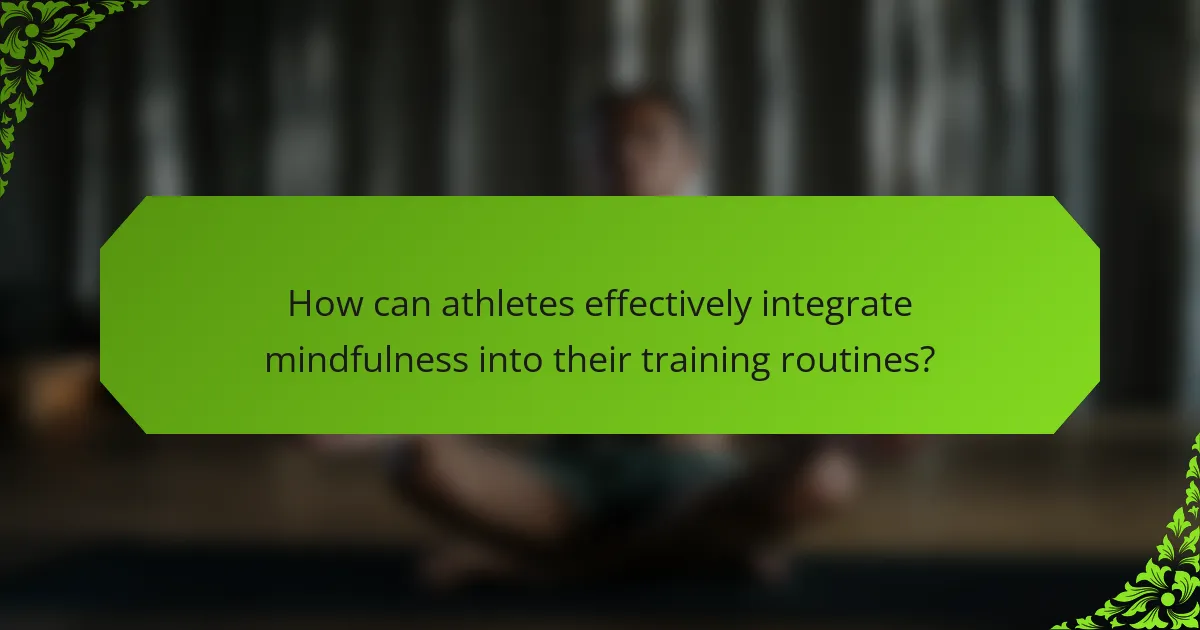Mindfulness practices significantly enhance athletic performance by improving focus and reducing anxiety. This article explores techniques like meditation and visualization, highlights their advantages for mental resilience, and offers strategies for effective integration into training routines. Additionally, it addresses common pitfalls that athletes should avoid to maximize the benefits of mindfulness.

What are the fundamental mindfulness practices for athletes?
Mindfulness practices for athletes include techniques such as meditation, breathing exercises, and visualization. These practices enhance focus, reduce anxiety, and improve performance. Regular integration into training routines can lead to better mental resilience and overall well-being. For example, athletes who practice mindfulness report increased concentration during competitions, enabling them to perform at their best.
How does mindfulness improve athletic performance?
Mindfulness significantly enhances athletic performance by improving focus, reducing anxiety, and promoting recovery. Techniques like meditation, breathing exercises, and visualization help athletes stay present and manage stress. As a result, athletes can perform better under pressure and maintain a competitive edge. Research indicates that athletes practicing mindfulness experience a 10-15% improvement in performance metrics. Integrating mindfulness into training routines fosters resilience and mental clarity, crucial for peak performance.
What techniques are commonly used in mindfulness for athletes?
Common techniques in mindfulness for athletes include breath awareness, body scanning, visualization, and mindful movement. These practices enhance focus, reduce anxiety, and improve performance. Breath awareness centers attention and regulates emotions. Body scanning promotes relaxation and body awareness. Visualization helps athletes mentally rehearse and prepare for competition. Mindful movement, such as yoga or tai chi, integrates physical activity with mindfulness, fostering both mental and physical well-being.
What is the role of breathing exercises in mindfulness?
Breathing exercises play a crucial role in mindfulness by enhancing focus and reducing stress. They promote awareness of the present moment, allowing athletes to connect with their bodies and emotions. This practice improves concentration and mental clarity, essential for peak performance. Additionally, controlled breathing can lower heart rate and anxiety levels, contributing to overall well-being. Integrating these exercises into training routines fosters resilience and mental fortitude, making them a valuable tool for athletes.
How can visualization techniques enhance focus?
Visualization techniques significantly enhance focus by providing mental clarity and reducing distractions. These techniques allow athletes to create vivid mental images of their performance, improving concentration and confidence. For instance, studies show that visualization can increase performance by up to 20%. Additionally, athletes who regularly practice visualization report heightened awareness during competitions. This practice integrates seamlessly with mindfulness techniques, fostering a holistic approach to mental preparation.
What are the benefits of body scanning for athletes?
Body scanning enhances athletes’ performance by promoting awareness of physical and mental states. It improves focus, reduces stress, and fosters better recovery. Regular practice can lead to increased resilience and improved emotional regulation. Additionally, athletes can identify areas of tension, allowing for targeted interventions and injury prevention.

What unique advantages does mindfulness offer to athletes?
Mindfulness offers unique advantages to athletes by enhancing focus, reducing anxiety, and improving performance. These practices foster mental resilience, enabling athletes to better manage stress during competition. Mindfulness techniques, such as breath control and visualization, help athletes maintain a present-focused mindset, which can lead to improved decision-making and execution. Additionally, studies have shown that regular mindfulness practice can enhance recovery and overall well-being, contributing to long-term athletic success.
How does mindfulness contribute to mental resilience?
Mindfulness enhances mental resilience by promoting emotional regulation and stress management. Techniques like meditation and focused breathing help athletes maintain composure under pressure. Regular practice fosters self-awareness, enabling quicker recovery from setbacks. Research indicates that mindfulness can reduce anxiety levels, improving overall performance and focus.
In what ways can mindfulness reduce performance anxiety?
Mindfulness can significantly reduce performance anxiety by promoting relaxation and enhancing focus. Techniques such as deep breathing and visualization help athletes manage stress responses. Research indicates that mindfulness practices can lead to improved emotional regulation and resilience, allowing athletes to perform under pressure. Regular integration of mindfulness into training routines fosters a mental state conducive to peak performance, ultimately reducing anxiety levels during competitions.
How does mindfulness enhance recovery and injury management?
Mindfulness practices significantly enhance recovery and injury management for athletes by promoting mental resilience and reducing stress. Techniques such as meditation and breathing exercises improve focus and emotional regulation, facilitating a faster healing process. Research indicates that athletes who engage in mindfulness experience lower anxiety levels, which can accelerate recovery times. Additionally, integrating mindfulness into training routines fosters a greater awareness of bodily sensations, helping athletes identify potential injuries earlier. This proactive approach not only aids in physical recovery but also enhances overall performance.

What rare attributes of mindfulness practices can athletes leverage?
Athletes can leverage rare attributes of mindfulness practices, such as enhanced sensory awareness and emotional regulation. These attributes allow athletes to better connect with their physical sensations and manage stress effectively. Research indicates that practices like body scanning and mindful breathing can lead to improved focus and performance under pressure. Additionally, integrating mindfulness into training routines fosters resilience and adaptability, crucial for peak athletic performance.
Are there specific mindfulness techniques tailored for team sports?
Yes, specific mindfulness techniques exist for team sports, enhancing focus and collaboration. Techniques include collective breathing exercises, visualization of team success, and mindful communication practices. These methods foster unity and improve performance through shared mental states. Engaging in team mindfulness sessions can lead to increased cohesion and reduced anxiety, contributing to overall athletic success.
How can mindfulness practices be adapted for extreme sports?
Mindfulness practices can enhance focus and resilience in extreme sports. Techniques such as visualization, breathing exercises, and body scans help athletes manage stress and improve performance. Integrating mindfulness into training routines fosters mental clarity and emotional regulation, essential for high-stakes environments. Regular practice can lead to improved decision-making and reduced anxiety during competitions.

How can athletes effectively integrate mindfulness into their training routines?
Athletes can effectively integrate mindfulness into their training routines by practicing techniques such as meditation, breathing exercises, and body awareness. These practices enhance focus, reduce stress, and improve performance. Regularly scheduling mindfulness sessions during training can strengthen mental resilience. Additionally, incorporating mindfulness into warm-ups and cool-downs can promote recovery and enhance overall well-being. Athletes who consistently apply these techniques report greater clarity and emotional regulation, leading to improved competitive outcomes.
What are practical steps for incorporating mindfulness into daily practice?
Incorporating mindfulness into daily practice enhances focus and performance. Start with short meditation sessions, gradually increasing duration. Integrate breath awareness during workouts to maintain focus. Use visualization techniques before competitions to enhance mental clarity. Establish a routine by setting specific times for mindfulness practices, ensuring consistency. Finally, reflect on experiences to identify improvements and areas for growth.
How can coaches support athletes in adopting mindfulness practices?
Coaches can support athletes in adopting mindfulness practices by integrating techniques into training routines. Encouraging regular practice enhances focus and reduces anxiety. Coaches can introduce breathing exercises, visualization, and body scans to help athletes develop self-awareness. Providing a structured environment for these practices fosters consistency and commitment.

What common mistakes should athletes avoid when practicing mindfulness?
Athletes should avoid distractions, unrealistic expectations, and inconsistent practice when practicing mindfulness. Focusing on the present moment enhances performance, but common errors can hinder progress.
Distractions can stem from external factors like noise or internal thoughts. Athletes must cultivate an environment conducive to mindfulness. Unrealistic expectations can lead to frustration; instead, setting achievable goals fosters a positive mindset. Inconsistent practice disrupts the benefits of mindfulness; regularity is key to reaping its advantages.
By recognizing and addressing these mistakes, athletes can enhance their mindfulness practices, leading to improved focus and performance.
How can athletes maintain consistency in their mindfulness practice?
Athletes can maintain consistency in their mindfulness practice by establishing a routine, setting clear intentions, and utilizing guided sessions. A daily schedule helps integrate mindfulness into training. Setting specific goals enhances focus and motivation. Guided sessions, whether through apps or instructors, provide structure and support. Regular reflection on progress fosters accountability and encourages continued practice.
What expert insights can enhance mindfulness application in sports?
Expert insights can significantly enhance mindfulness application in sports by focusing on tailored techniques and their benefits. Techniques such as breath control, visualization, and body scanning promote focus and reduce anxiety. Research indicates that athletes who practice mindfulness experience improved performance metrics and mental resilience. Integrating mindfulness into training routines fosters a holistic approach, enhancing both physical and mental aspects of athletic performance. Unique attributes like personalized mindfulness plans can further optimize individual athlete needs, leading to greater overall success.


